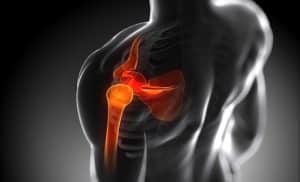Shoulder Injury
Shoulder Joint Injuries - Learn Basics

Shoulder Injury
While it is a term commonly used, shoulder joint requires a little more explanation. The shoulder is formed with 7 joints who move in a synchronized manner, with each joint being incumbent upon the other. Each joint is important for the overall function of the shoulder. The synchronous movements that occur simultaneously in a smooth integrated manner by the joints is called the scapulohumeral rhythm. Personal injury such as a slip and fall or automobile accident injures any of the 7 joints of the shoulder. Any impairment due to injury to a single joint can affect the rest of the joints and consequently the overall shoulder complex.
If you have sustained damage to your shoulder in a car accident, slip and fall or other scenario, early medical intervention is imperative to future health. Learn more about the complexity of the shoulder in the following article.
Learn Shoulder Joint Anatomy
To provide simplicity, the shoulder complex could be understood from the individual functionality of the individual joints. And although that is unphysiological given the functional impossibility of the joints, research shows that the shoulder analysis is best understood if each joint was to be considered separately.
The shoulder complex and its joints are shown in the picture below
1 = Glenohumeral 2 = Suprahumeral
3 = Acromicolavicular 4 = Scapulocstal
5 = Sternoclavicular 6 = Costosternal
7 = Costovertebral
The costovertebral joint is the initial joint between the ribs and the vertebral body. The costosternal is the next contiguous joint follwed by the sternoclavicular joint. These three joints are unions of 2 bones that permit their moevement. And for that reason, these three joints are said to conform to the definition of a joint. However, the scapulocostal joint which is the remaining articulation of the trunk portion of the shoulder complex does not cnform as much. It is a gliding joint of the scapula with the rib cage seperated by muscles and a bursa. Hence, only conforms equivocally.
The arm begins with the acromicolavicular joint. Then comes the suprahumeral joint which is also a functional joint. It is a joint that represents the relationship between the humeral head and the coracoacromial arch. The suprahumeral joint is extremely important for the normal movement of the shoulder and an essential part in many of the pathological states.
The last joint is the glenohumeral, which is commonly considered the shoulder joint. It has pathalogical importance but not much functional significance.
Failure of any component movement of these joints will cause failure of the composite movement of the shoulder complex.
The Glenohumeral Joint
Also termed the scapulohumeral, this joint that links the humerus and the scapula, which is the shoulder blade. The scapula lies on the posterior surface of the thoracic cage, with its ventral surface incurvate corresponding to the convex surface of the rib cage.
The spine of the spacula on the posterior divides the blade into the supra and infraspinatus fossae. The saggittal illustrates the relationship of the glenoid fossa to the overhanging acromial process and the medially located coracoid process.
The Suprahumeral Joint
This is a protective articulation between the head of the humerus an an arch that prevents trauma. It is boiunded by the glonoid cavity anteriorly and medially by the coracoid process and posteriorly by the acromial process.
The Acromicolavicular Joint
This joint is a plane joint that connects the outer end of the clavicle with its convex facet to the anterior part of the acromial process. There is a bridge that may exist called the fibrocartilaginous ring. The clavicle and the acromial process are connected via this bridge when joint space does not exist (usually at the age of 2 years). When joint space starts to exist (age 3), a disk between the clavicle and the acromial process appears.
The Sternoclavicular Joint
This joint is formed by the attachement of the sternal end of the clavicle and the superiorlateral lateral part of the manubrium of the sternum and the cartilage of the first rib.
Shoulder Joint Personal Injury Attorney Guidance

Shoulder Joint Personal Injury Attorney Guidance
Shoulder injuries are extremely serious. Damage to single joint can affect the person's entire arm, hindering work and life's enjoyable activities. Immediate medical attention should be sought. Fortunately for those who suffer this type of bodily harm, surgery is often successful in restoring range of motion and eliminating pain. If your shoulder is damage by the negligent behavior of a driver or other person, you may have an insurance claim and personal lawsuit against the individual or entity that caused the dangerous condition to exist. The Napolin Law Firm can help you get medical care, prosecute your case and apply for supplemental income after a car, truck, bus, pedestrian, motorcycle or bicycle accident. Get help and guidance now! Call the Napolin lawyers and get a free legal lawsuit evaluation of your circumstances and same-day medical attention at no cost up front! Free consults are available to those who believe someone else caused their issue.
Injury Lawyer
844-984-4878
Free Case Consultation
Our Promise:

